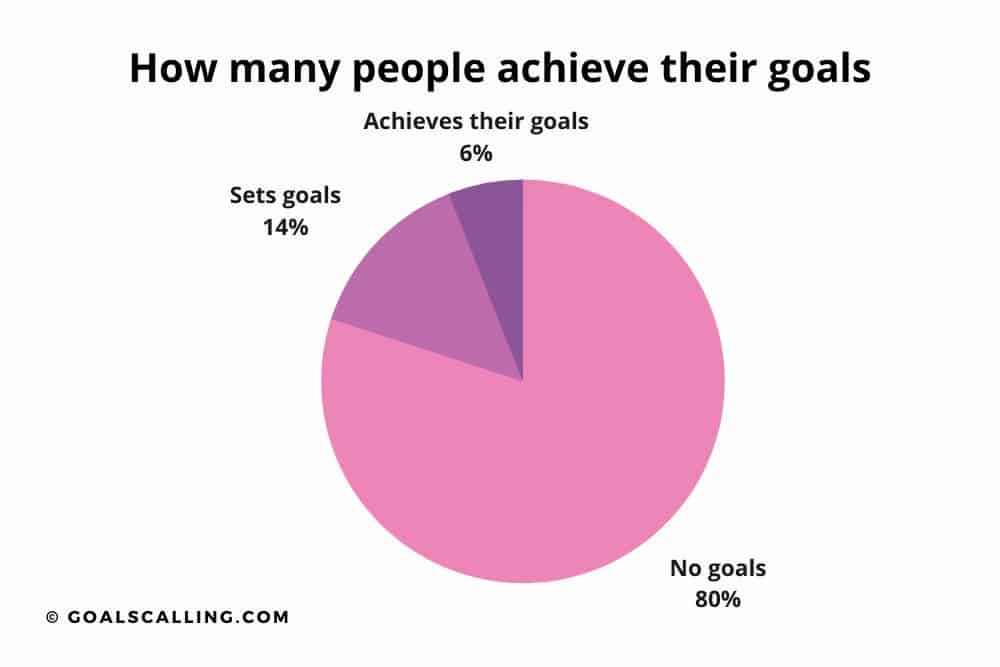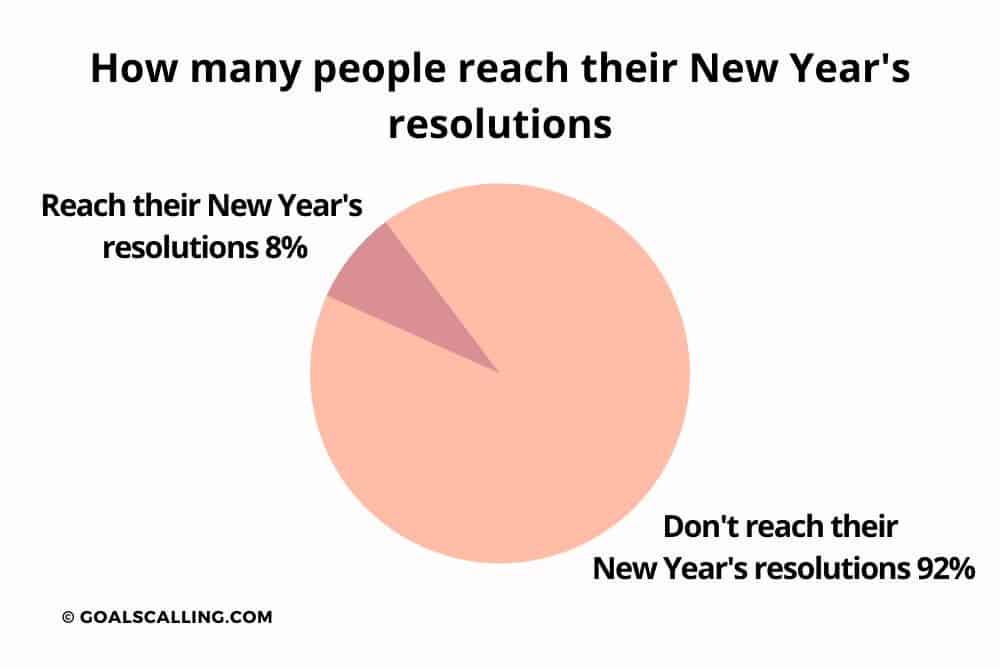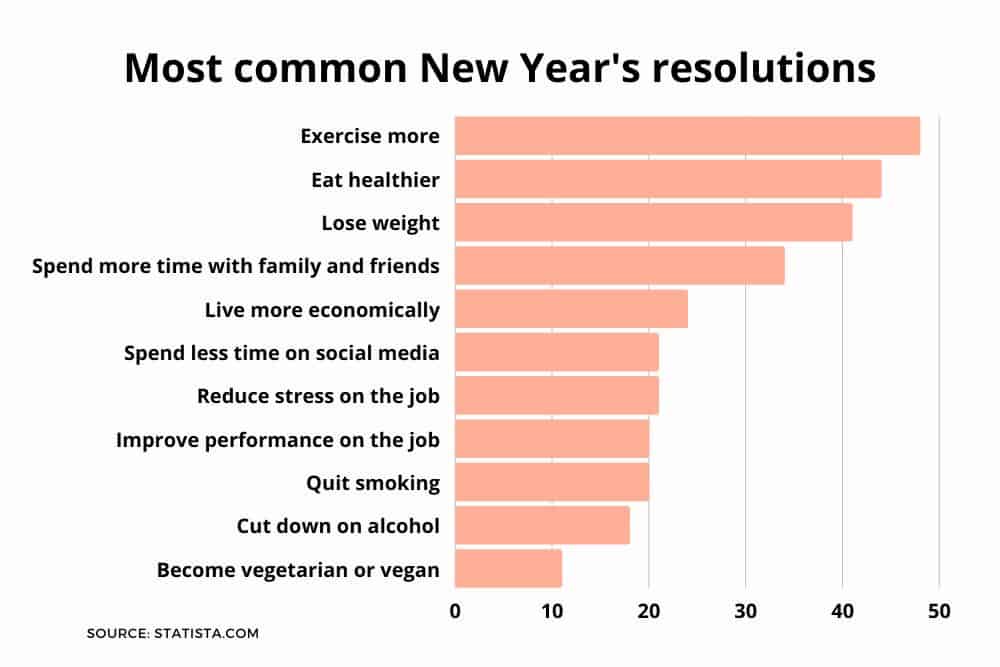How Many People Reach Their Goals? Goal Statistics 2024

Everyone has dreams and goals and the rise of the self-made entrepreneur and the #bossbabe movements are here to push people to stop settling for less and start building something better. I myself am a big believer in going after your goals. But what are the goal statistics that tell us how many people actually reach their dreams?
How many people even set goals? How many people fail and never make their dreams come true?
On this page you will find all the relevant statistics about goals and goal setting.
What percentage of people achieve their goals?
Do you feel like everyone has big plans for their future? Well, the great majority of people don’t even set goals, and even fewer stick to them. According to Reliable Plant, only 20% of people set goals for themselves, which means that 80% of people don’t set goals.
What’s even more unfortunate is that out of the 20% of people who do set goals, only about 30% of people will succeed. That means that only a third of those people who set goals actually achieve them and of all people, that makes 6%.
Setting goals is definitely a good idea if you want to make your life better though: people who have goals are 10 times more likely to succeed.

Writing down goals statistics: What percentage of goals are achieved when written down?
Not all goals are created equal. Simply telling yourself that you want to become a published author doesn’t mean much yet. But writing your goal down is when things start happening. Planning well helps you reach your goals.
However, most people don’t do this. Less than 3% of Americans write down their goals and less than 1% work on their goals every day by reviewing and, if necessary, rewriting them, according to Brian Tracy.
Dr. Gail Matthews conducted a study that clearly showed that people who write down their goals are more likely to achieve them. In fact, you are 42% more likely to reach your goals if you write them down.
In Matthews’s study, 61% of goals that were written down were achieved. Note that taking extra action, such as sharing your goals with your friend increases this number.
It’s also worth noting that in 90% of studies, setting specific and challenging goals led to much better results. This isn’t exactly surprising because it is hard to take action on your goals if you don’t know what exactly you are asking from yourself and it’s very easy to forget about goals that you set on a whim or that don’t matter much to you.
What percentage of people meet their New Year’s resolutions?
I happen to believe in New Year’s resolutions, but most people either don’t bother setting them or don’t even take them seriously. Only 8% of people who set New Year’s resolutions actually reach them, which means that 92% of people fail. 62% of people give up on their resolutions within a month. It’s no wonder that New Year’s resolutions have a bit of a bad reputation.
It definitely doesn’t have to be like that though. If you set the right goals and you make them achievable, your chances of succeeding in them can be much higher than you could even imagine.

Sharing goals statistics: does sharing your goals increase your chances?
As already mentioned, writing down your goals increases your likelihood of reaching them: 43% of people who simply think about their goals reach them, and writing them down increased the percentage to 61%.
In Matthews’s study, the group of people who wrote their goals down, formulated action commitments, and shared their goals with their friends had a 64% chance of achieving their goals.
This means that sharing your goals does help, but it is especially effective when combined with other techniques, such as creating detailed plans.
It is also worth noting that in the study there was one group of people who performed clearly better than anyone else. The group that was asked to write their goals down, formulate action commitments and send reports about their weekly progress to their friends achieved 76% of their goals.
Visualizing goals statistics
Does visualizing your goals help you achieve them?
It sure does! According to a survey, imagining your goals and keeping images or vision boards at hand makes you twice as confident about your ability to reach your goal. Only 31% of those who don’t visualize their goals feel confident, compared to 59% of those who do.
People who visualize their financial goals are less likely to feel anxious about budgeting than those who don’t (16% vs. 29%) and they feel more accomplished overall (73% vs. 50%), according to a study by TD Bank.
What percentage of people fail to achieve their goals?
Taking your goals seriously, writing them down, and visualizing them definitely helps, as we have seen. But overall, 70% of people fail to achieve their goals.
This doesn’t mean that you should feel discouraged or think that going after your dreams is naive. No matter what you want from life, you have to create a good, actionable plan and then work hard on your goals. The harder you work, the higher your odds are.
What are the most common goals?
A lot of people have the same goals and they often revolve around finances and health. Some of the most common goals for Americans were getting out of debt (35%) and becoming more organized (34%).
New Year’s resolutions are possibly the clearest indicator of what are the most common goals that people set. American’s plans for 2022 were as follows:

Here are the exact numbers:

Source: Statista.com
***
Did you find these goal statistics interesting? What surprised you the most? Make sure to share this article if you found it useful!


Good article! Thank you!
Thank you, I’m glad if you found it useful!
How much more likely are you to stick to a small goal vs an ambitious one?
I’d say it really depends on how much you care about the goal. People often set small goals like “journal every morning” or “floss once a day” and then forget about it two days later. But big goals are different, they are often based on dreams that you’ve had for a while already and they have the potential to make your life much better.
Since you asked about sticking to a goal and not about reaching it, I’d say ambitious goals are the answer. People think about them more, are more passionate about them, and are more likely to be willing to put in the time and effort because reaching those goals would change their life. As good as flossing is, it’s not exactly going to change your life.
What would happen if you re-framed an ambitious goal (big one) as an accumulation of various small goals?
Any large goal is a set of very, very small goals compounded over a number of many years. Viewing the ambitious goal in its entirety makes it seem so overwhelming. Breaking it up into a set of small procedures makes it seem a lot less daunting. You wouldn’t see it come to fruition for a very long time so it would seem that faith in the procedure is necessary while you’re waiting for the prolonged consequence to manifest itself in your life.